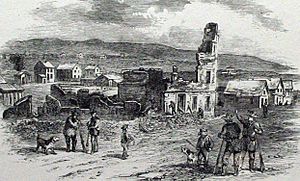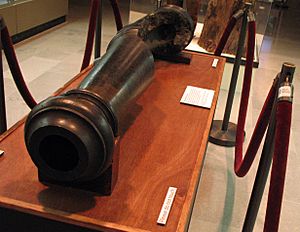Sacking of Lawrence facts for kids
Quick facts for kids Sacking of Lawrence |
|||||||
|---|---|---|---|---|---|---|---|
| Part of Bleeding Kansas | |||||||
 Ruins of Free State Hotel after the attack |
|||||||
|
|||||||
| Belligerents | |||||||
| Free-State Abolitionists | Pro-slavery settlers | ||||||
| Commanders and leaders | |||||||
| Samuel C. Pomeroy (de facto) | Samuel J. Jones | ||||||
| Strength | |||||||
| abolitionist civilians | 800 | ||||||
| Casualties and losses | |||||||
| 1 wounded | 1 dead | ||||||
The Sacking of Lawrence was an attack on the town of Lawrence, Kansas, on May 21, 1856. People who supported slavery attacked the town. Lawrence was known as an anti-slavery town. The attack was led by Douglas County Sheriff Samuel J. Jones. This event made the fighting in Kansas Territory much worse. These conflicts were later called "Bleeding Kansas".
Only one person died during the attack, and it was by accident. However, the attackers destroyed two anti-slavery newspapers. These were the Kansas Free State and the Herald of Freedom.
Why Lawrence Was Attacked
Lawrence, Kansas was started in 1854 by people who were against slavery. Because of this, the town was often attacked by people who supported slavery. Lawrence had almost been attacked before, during the Wakarusa War in 1855.
Pro-slavery Sheriff Samuel Jones was shot while trying to arrest some anti-slavery people. Many anti-slavery people believed that this shooting caused the attack on Lawrence. The people of Lawrence made Jones leave after he was shot. A federal officer named Israel B. Donaldson said that Jones being shot stopped him from doing his job. So, Donaldson decided to send 800 pro-slavery men to Lawrence. Their goal was to destroy anti-slavery newspapers and the Free State Hotel.
The Attack Begins
On May 21, 1856, Sheriff Jones and Marshal Donaldson arrived in Lawrence. A large group of men gathered on Mount Oread. They even had a cannon with them. Charles L. Robinson's house was taken over and used as Jones's main base. Jones's men guarded all the roads into and out of Lawrence. This was to stop anyone from leaving.
Jones's men carried many flags. Some were state flags from Alabama and South Carolina. Many flags also had messages like "Kansas the Outpost" or "Southern Rights."
The owner of the Free State Hotel, Shalor Eldridge, heard about the approaching pro-slavery men. He went to meet them. Donaldson told him that they would only attack Lawrence if the town fought back. Donaldson and Eldridge then went to the Free State Hotel. Eldridge prepared a large meal with fresh food and expensive wine. He hoped this would keep Donaldson and his men calm. Donaldson interviewed Eldridge while his men ate. Then, they left without paying.
Soon after, Donaldson let Jones take charge of the men. Jones asked to speak with a town leader. Samuel C. Pomeroy agreed to meet with Jones. Jones clearly stated what he wanted: for the people of Lawrence to give up all their weapons. Pomeroy explained that he could not force the people to do this. However, hoping to make Jones leave peacefully, Pomeroy agreed to give up the town's only artillery piece. Jones took this cannon, but it did not make him leave as Pomeroy had hoped.
Destroying the Town
The pro-slavery attackers used the "Old Sacramento" cannon to try to destroy the Free State Hotel. This cannon had been kept in the Liberty Arsenal. Pro-slavery forces had taken it in 1855. (Later in 1856, anti-slavery fighters would take this cannon during the Second Battle of Franklin.)
While Jones and his men were trying to destroy the hotel, they also attacked the newspaper offices. The printing offices of the Kansas Free State and the Herald of Freedom were destroyed. Their libraries were thrown out the window. The printing presses were smashed. The metal letters used for printing were thrown into the river. Any papers left were either scattered by the wind or used by Jones's men to burn down the Free State Hotel.
After the newspapers and the hotel were destroyed, Jones's men began to loot the town. As they left, they also burned Robinson's home on Mount Oread.
Only one person died during the attack. He was a member of Jones's group. He was hit in the head by a piece of the Free State Hotel as it fell apart.
What Happened Next
Even though the Free State Hotel was destroyed, Shalor Eldridge bought the ruins. He decided to rebuild it as the "Eldridge House". This building stood until 1863. Then, it was burned down by William Quantrill during the Lawrence Massacre. The hotel would be rebuilt two more times, in 1866 and 1926.
For many months after the Sacking of Lawrence, the city did not have an anti-slavery newspaper. Josiah Miller, who ran the Kansas Free State, decided not to start his newspaper again. However, George Brown restarted the Herald of Freedom in November 1857. So, Lawrence had a newspaper once more.
Lawrence also lost its only cannon during the attack. This was one reason why anti-slavery fighters attacked Franklin's Fort in June and August of 1856. They hoped to get the "Old Sacramento" cannon back for their own use.
- Smiley, Jane. The All-True Travels and Adventures of Lidie Newton: A Novel (1998; ISBN: 0-00-225743-2). This is a historical book about the attack on Lawrence and other events in Kansas Territory's history.


